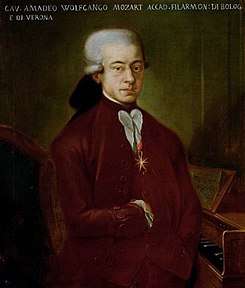Piano Concerto No. 6 (Mozart)
The Piano Concerto No. 6 in B-flat major, K. 238, was composed by Wolfgang Amadeus Mozart in January 1776. His Concerto No. 7 (K. 242) for three pianos and his Concerto No. 8 (K. 246) in C major would follow within three months. The three works share what Cuthbert Girdlestone refers to as a galant style.[1]
| Piano Concerto in B-flat major | |
|---|---|
| No. 6 | |
| by W. A. Mozart | |
 The young composer, a 1777 copy of a lost painting | |
| Catalogue | K. 238 |
| Style | Classical period |
| Composed | 1776 |
| Movements |
|
| Scoring |
|
The work is structured in three movements:
The work is scored for two flutes, two oboes, two horns, solo piano, and strings. It is a lightly textured work from early in Mozart's career. The United States Library of Congress holds the autograph score. Mozart had intended to publish the score after he composed it, but it did not appear in print until after his death, in 1793.[2] He did, however, perform the work, in Munich in 1777,[3] and in Augsburg on 22 October 1777. His student Rose Cannabich performed the work in Mannheim on 13 February 1778.[2] Angela Hewitt observes that the first performances of the work were probably on a harpsichord rather than a fortepiano.[4]
Music
The first movement, in sonata form, is marked Allegro aperto. "Aperto" literally means "open", an attribute often used in Mozart's early concertos, and while the exact meaning Mozart intended is unknown, it conveys "radiance and gaiety", as the pianist Angela Hewitt notes.[4] The development offers an episode of minor mode arpeggios and broken octaves in the piano, contrasted by "plaintive intervals"[4] of the oboe. It is in the development, and only there, that Girdlestone considers that the movement "gives us a glimpse of the true Mozart", as the recapitulation reprises the "well-bred, aristocratic good temper" of the movement's opening.[5] Mozart provided a short cadenza.[4]
In the second movement, in E-flat major and marked Andante un poco adagio, two flutes replace the oboes of the first movement.[4] The music is simple and gentle. Hewitt traces elements of the Andante in the Concerto in C major, K. 467: "the use of a triplet accompaniment, muted strings, and a pizzicato bass".[4] She notes a "marvellous effect of chiaroscuro"[4] by switching between major and minor keys, a technique adopted in many of his later works.[4]
In the final Rondeau, the oboes return instead of the flutes, but the horns receive prominence. Hewitt recalls, that Mozart asked his sister once to remind him "to give the horns something worthwhile to do". They contribute to the dance-like character of the movement. A section in G minor is called "the one really virtuoso page of the concerto, requiring some very nimble Baroque-style fingerwork".[4] Mozart wrote another short cadenza, with rests that still should be improvised by the soloist.[4]
References
- Girdlestone, Cuthbert (1948). Mozart's Piano Concertos. London: Cassell. p. 82. OCLC 247427085.
- Irving, John (2015). "Liner notes: Mozart Piano Concertos Nos. 5 in D major & 6 in B flat major; Three Concertos, K 107 (Brautigam/Willens/BIS)" (PDF). Retrieved 12 March 2017.
- Girdlestone, Cuthbert (1948). Mozart's Piano Concertos. London: Cassell. p. 88. OCLC 247427085.
- Hewitt, Angela (2011). "Piano Concerto No 6 in B flat major, K238". Hyperion Records. Retrieved 12 March 2017.
- Girdlestone, Cuthbert (1948). Mozart's Piano Concertos. London: Cassell. p. 85. OCLC 247427085.
External links
- Concerto in B KV 238: Score and critical report (in German) in the Neue Mozart-Ausgabe
- Piano Concerto No. 6 (Mozart): Scores at the International Music Score Library Project (IMSLP)